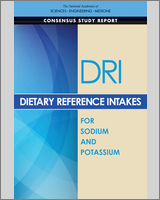From: Summary

Dietary Reference Intakes for Sodium and Potassium.
National Academies of Sciences, Engineering, and Medicine; Health and Medicine Division; Food and Nutrition Board; Committee to Review the Dietary Reference Intakes for Sodium and Potassium; Oria M, Harrison M, Stallings VA, editors.
Washington (DC): National Academies Press (US); 2019 Mar 5.
Copyright 2019 by the National Academy of Sciences. All rights reserved.
NCBI Bookshelf. A service of the National Library of Medicine, National Institutes of Health.